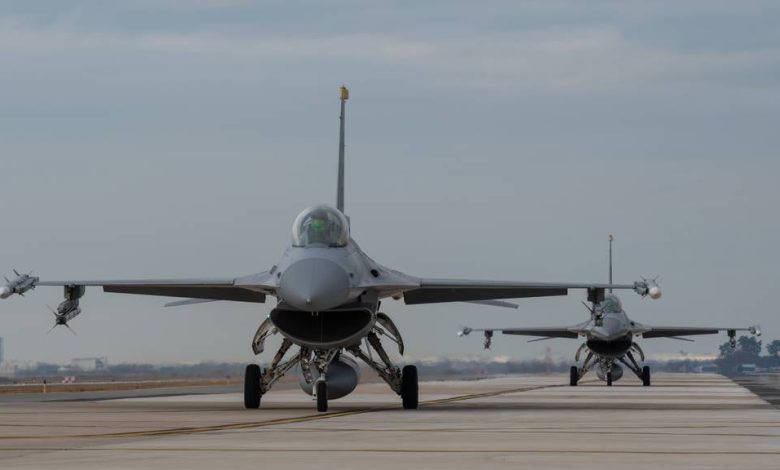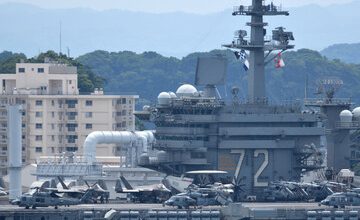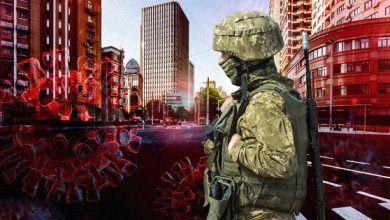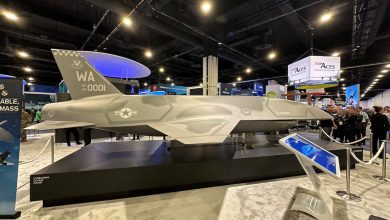A month ahead of Washington’s NATO summit, where are Ukraine’s jets?

BRUSSELS — At last year’s NATO summit in Vilnius, Lithuania, 11 member countries pledged to train Ukrainian pilots to fly the F-16 fighter jet. It was a major decision, one that enabled the eventual choice to send the jets themselves, an upgrade to Ukraine’s air force that officials in Kyiv had wanted for more than a year.
But almost a year later, and only weeks before the next NATO summit, in Washington, those F-16s have yet to arrive. In fact, despite a commitment that those planes will start reaching Ukraine by the end of this summer, issues with their delivery are becoming clearer — from the number of pilots who will be able to fly them to crews ready to keep them working.
“The training pipeline on the F-16s is pretty meager,” said a senior U.S. defense official, speaking with reporters on the condition of anonymity to talk candidly.
F-16s hold the promise to firm up Ukraine’s self-defense. The fighters would bring its air force closer to NATO-style tactics and systems, making it easier to work with the alliance overall. And they could lengthen Ukraine’s range at a moment when other countries are dropping restrictions on what targets its military can choose.
“It gives them some options,” said CQ Brown, America’s top military officer, in a short interview this week.
And yet, it’s not sure how much of an option those fighters will be in the near-term. These are the two sides of delivering F-16s to Ukraine. One one hand, they could begin a long-term transformation of its airpower. But on the other, actually getting them there has proven frustratingly long-term as well.
“This is a huge undertaking,” said Jens Stoltenberg, secretary general of NATO.
The pipeline, the pilots
Stoltenberg spoke to a group of reporters near the doors of NATO’s headquarters in Brussels, shortly before a meeting of countries that gather each month to coordinate support for Kyiv.
Earlier in June, Ukrainian President Volodomyr Zelenskyy met with America’s Secretary of Defense Lloyd Austin in Singapore. And according to a post on Zelenskyy’s social media, the two discussed the group of countries supplying F-16s.
The Netherlands and Denmark are leading that effort, though other states like Norway and Belgium are also involved. The number of planes committed this year totals around 60, and Ukraine should start receiving those by the end of the summer.
That said, there have been multiple kinks in the process to deliver them, and make sure they’re useful.
The first is training. Between Europe and the U.S. there are only a dozen or so Ukrainian pilots learning to fly the planes right now, said the American defense official.
“That’s just a handful of pilots, and that’s just the pilots,” the official said.
Almost as crucial are the other members of the crew, such as maintainers, who keep the plane working. Brown made a similar point in the interview, saying that Ukraine will only be able to use as many planes as it has crews.
Training at Morris Air National Guard Base in Tucson, Arizona began last fall, and the first round of Ukrainian pilots graduated only weeks ago in late May. But finding spots for new ones has been difficult. There’s a small pool of Ukrainian pilots eligible for the training, which requires deep experience, and there’s already a queue of non-Ukrainian pilots in line as well.
A week before the meeting, Ukrainian officials told Politico that they had 30 or so pilots waiting for spots to start training but that none were available.
In a later press conference at NATO, Brown pushed back on the argument that European and American trainers are capped out.
“There is capacity,” he said.
The other issues are the length of the course itself — made more difficult by the highly technical English language training required — and finding a place to store them. Their usefulness will also depend on the stocks of munitions available to fire, which for other large weapons has been an issue throughout the war.
‘Wouldn’t want to rush it’
These issues aside, some analysts and defense officials are optimistic about what the jets could do for Ukraine’s force.
In a recent paper for the Center for Strategic and International Studies, U.S. military officers temporarily at the think tank argued that F-16s would threaten more Russian targets and help make Ukraine’s air force operate on standards similar to NATO’s — one of many goals as Kyiv pursues a spot in the alliance.
George Barros, who leads the Russia team at the Institute for the Study of War, told Defense News that the jets could be more useful considering the recent, if limited, policy change that allows Ukraine to fire across the border with Russia.
“We’ve written off the possibility of Ukrainians using air power in any meaningful way” to this point in the war, Barros said.
That could change, he argued, especially if the U.S. loosened its policy on striking into Russia even further.
In the interview on the way to Brussels, Brown was more cautious.
He, like other senior leaders in the Pentagon, urges people to think about how weapons and tactics work together rather than the effect of any one new piece of equipment.
“Just because they have the F-16s it’s not going to all of a sudden magically make things successful,” he said.
And that certainly won’t be the case, the other defense official argued, if the process moves faster than Ukraine can keep up with. Asked whether any planes would arrive by the Washington summit in July, the official said it would be better to wait if that meant they were more useful upon arrival.
“I wouldn’t want to rush it,” the official said.
Noah Robertson is the Pentagon reporter at Defense News. He previously covered national security for the Christian Science Monitor. He holds a bachelor’s degree in English and government from the College of William & Mary in his hometown of Williamsburg, Virginia.







